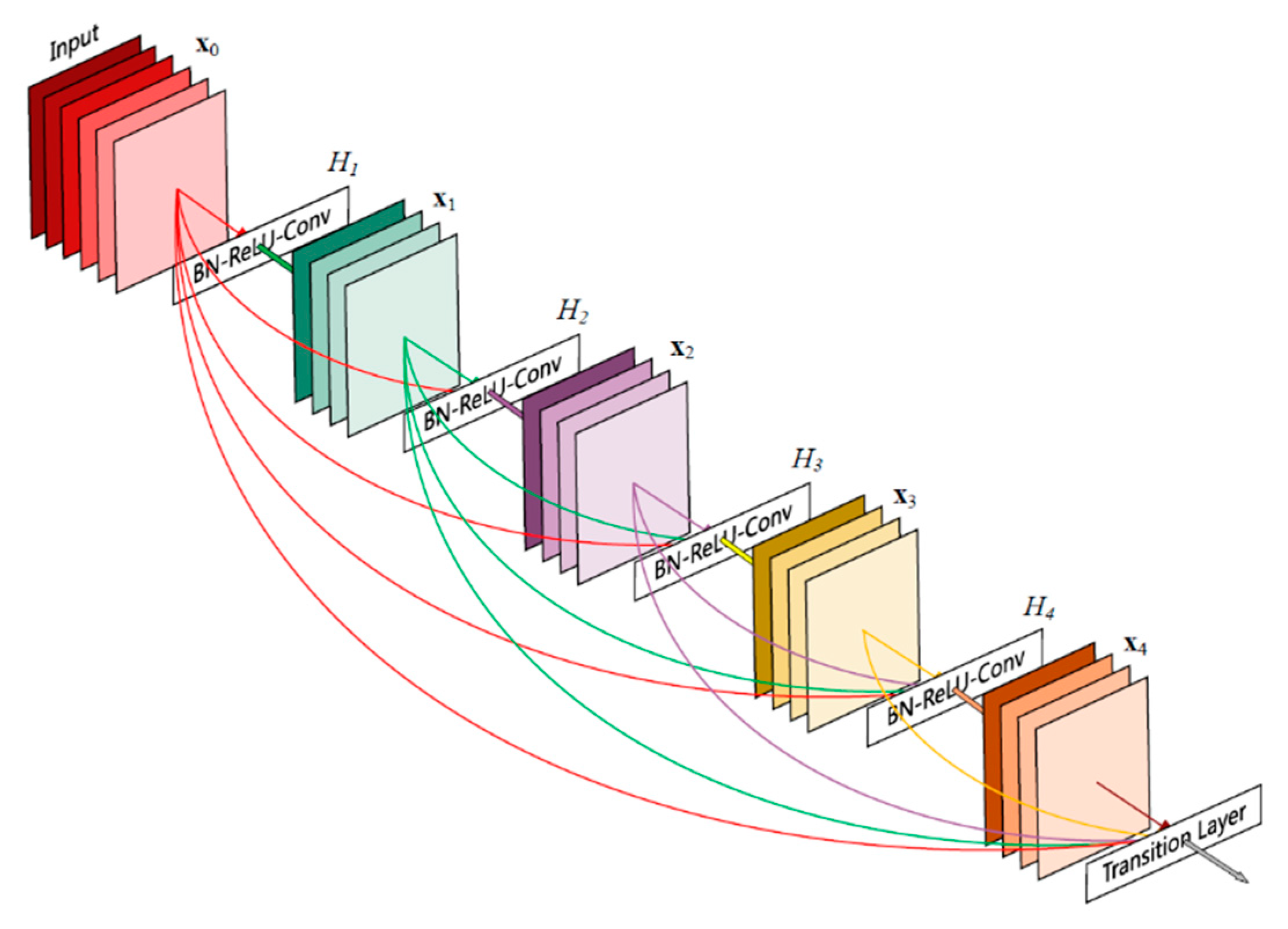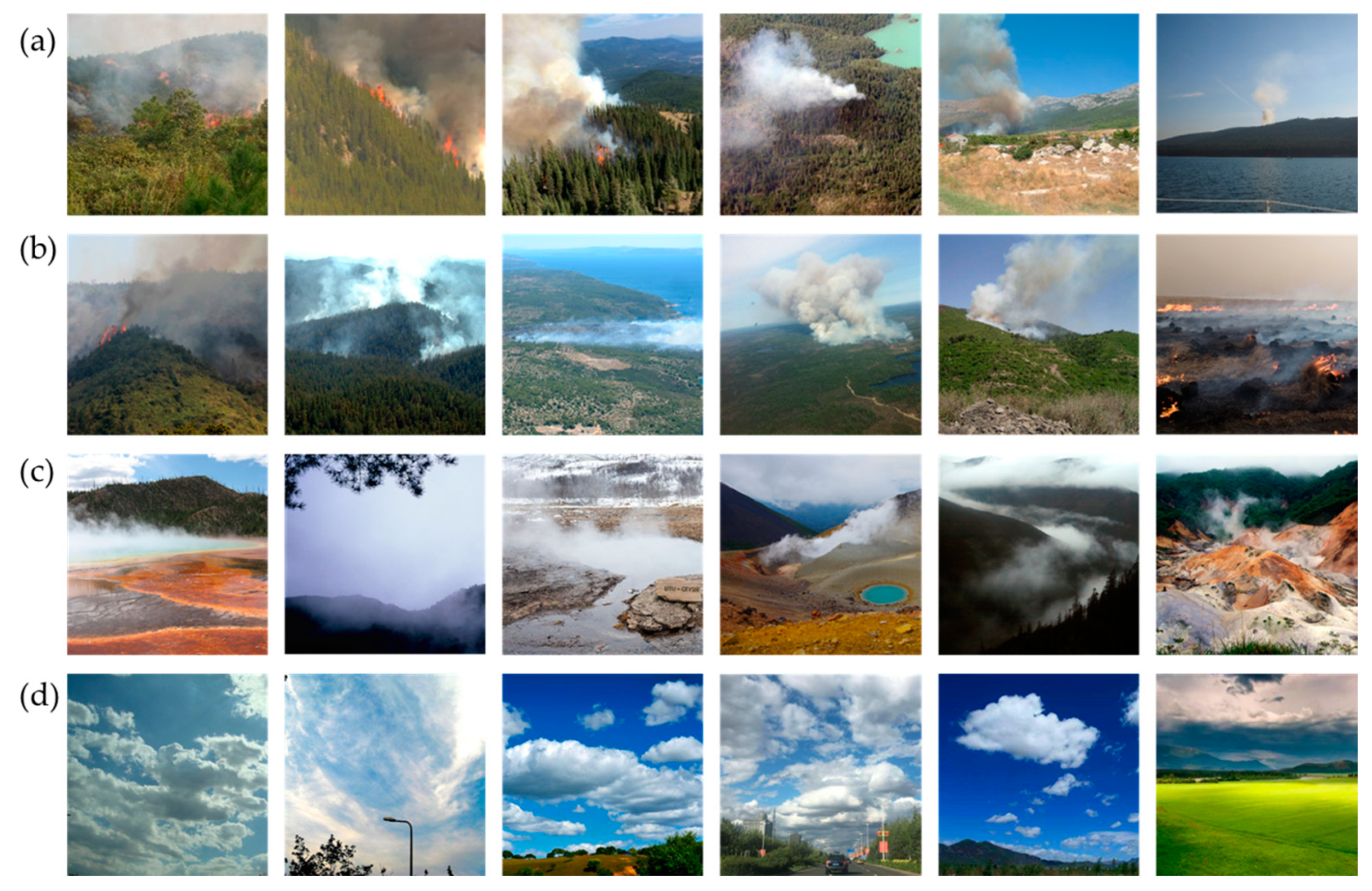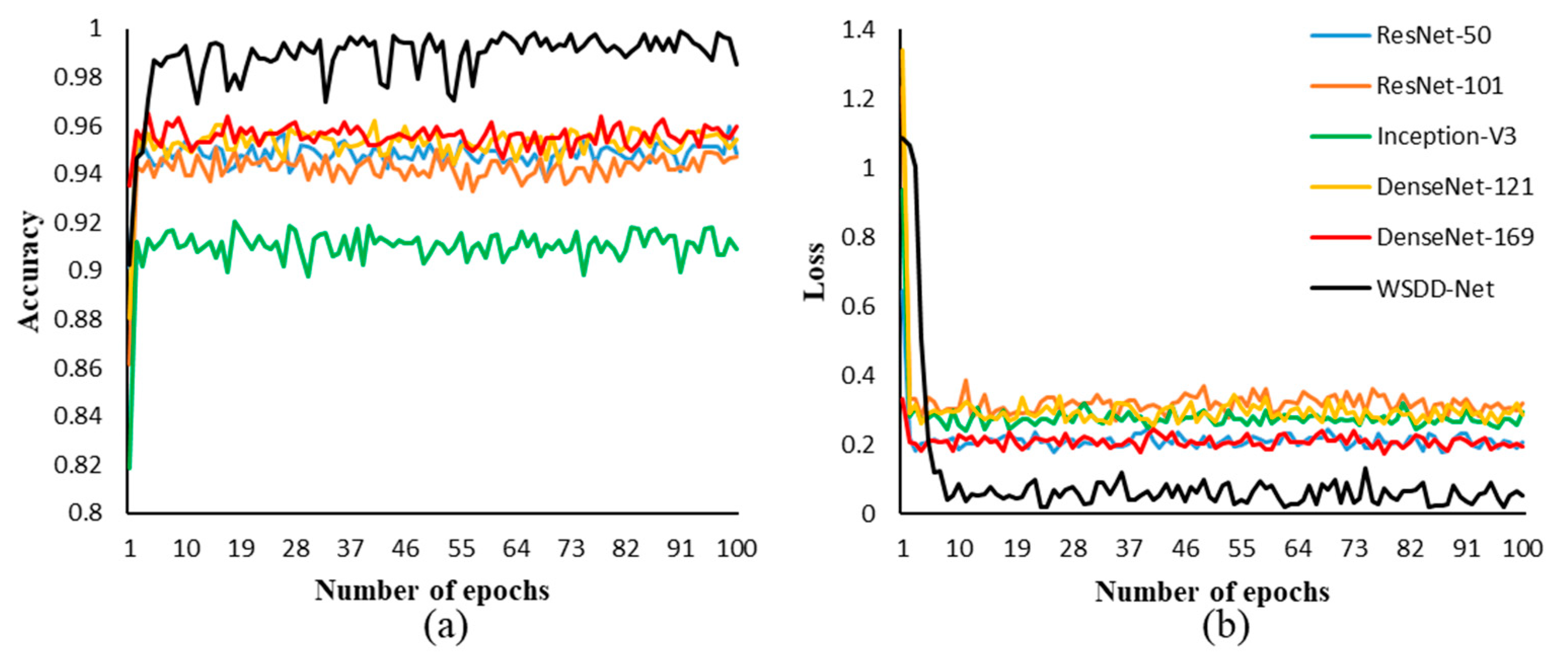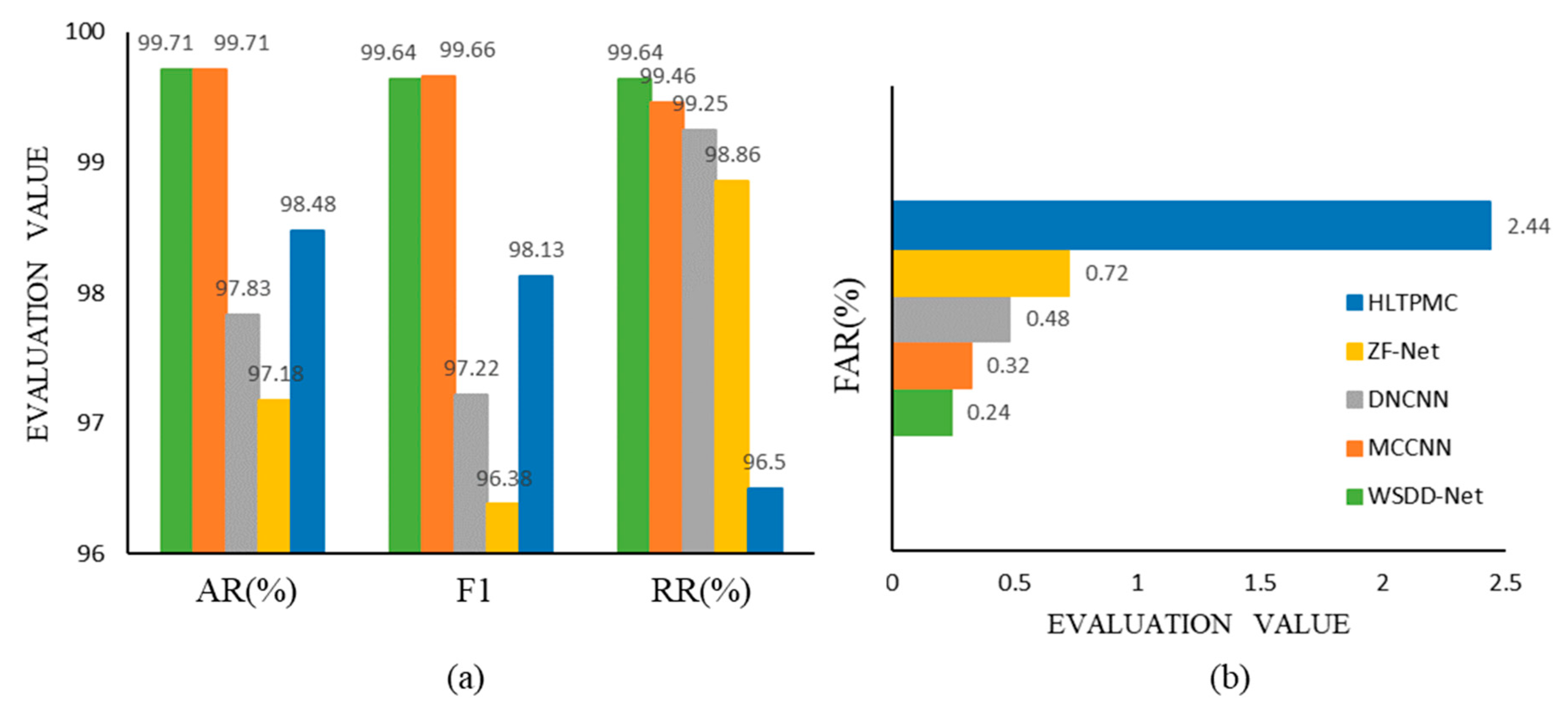Detection of Wildfire Smoke Images Based on a Densely Dilated Convolutional Network
Abstract
:1. Introduction
2. Related Work
3. Methods
3.1. Candidate Smoke Region Segmentation
3.2. Proposed WSDD-Net
3.2.1. DenseNet
3.2.2. Dilated Dense Connection (DDC)
3.3. Loss Function
4. Experimental Results
4.1. Wildfire Smoke Dataset
4.2. Evaluation Criterion
4.3. Results of the WS Dataset
4.4. Results on the Yuan Dataset
5. Conclusions
Author Contributions
Funding
Conflicts of Interest
References
- Luo, Y.M.; Zhao, L.; Liu, P.Z.; Huang, D.T. Fire smoke detection algorithm based on motion characteristic and convolutional neural networks. Multimedia Tools Appl. 2018, 77, 15075–15092. [Google Scholar] [CrossRef]
- Lin, G.H.; Zhang, Y.M.; Xu, G.; Zhang, Q.X. Smoke detection on video sequences using 3D convolutional neural networks. Fire Technol. 2019, 55, 1827–1847. [Google Scholar] [CrossRef]
- Yuan, F.N. A double mapping framework for extraction of shape-invariant features based on multi-scale partitions with AdaBoost for video smoke detection. Pattern Recognit. 2012, 45, 4326–4336. [Google Scholar] [CrossRef]
- Ko, B.C.; Cheong, K.; Nam, J. Fire detection based on vision sensor and support vector machines. Fire Saf. J. 2009, 44, 322–329. [Google Scholar] [CrossRef]
- Yuan, W.; Li, J.; Fang, J.; Zhang, Y.M. Color model and method for video fire flame and smoke detection using Fisher linear discriminant. Opt. Eng. 2013, 52, 027205. [Google Scholar]
- Yin, M.X.; Lang, C.Y.; Li, Z.; Feng, S.H.; Wang, T. Recurrent convolutional network for video-based smoke detection. Multimedia Tools Appl. 2019, 78, 237–256. [Google Scholar] [CrossRef]
- Xie, J.J.; Li, A.Q.; Zhang, J.G.; Cheng, Z.A. An Integrated wildlife recognition model on multi-branch aggregation and squeeze-and-excitation network. Appl. Sci. 2019, 9, 2794. [Google Scholar] [CrossRef]
- Gil-Martín, M.; Montero, J.M.; San-Segundo, R. Parkinson’s disease detection from drawing movements using convolutional neural networks. Electronics. 2019, 8, 907. [Google Scholar] [CrossRef]
- Li, Z.Q.; Chen, Z.X.; Wu, Q.M.J.; Liu, C.Y. Real-time pedestrian detection with deep supervision in the wild. Signal Image Video Process. 2019, 13, 761–769. [Google Scholar] [CrossRef]
- Xu, G.; Zhang, Y.M.; Zhang, Q.X.; Lin, G.H. Video smoke detection based on deep saliency network. arXiv 2018, arXiv:1809.02802. [Google Scholar] [CrossRef]
- Matlani, P.; Shrivastava, M. Hybrid deep VGG-NET convolutional classifier for video smoke detection. CMES Comput. Model. Eng. Sci. 2019, 119, 427–458. [Google Scholar] [CrossRef]
- Yang, B.H.; Zheng, D.; Zhang, Y.H.; Zheng, X.M. Recognition of fire detection based on neural network. In Life System Modeling and Intelligent Computing; Springer: Berlin/Heidelberg, Germany, 2010; pp. 250–258. [Google Scholar]
- Zhang, Z.J.; Shen, T.; Zou, J.H. An improved probabilistic approach for fire detection in videos. Fire Technol. 2014, 50, 745–752. [Google Scholar] [CrossRef]
- Tung, T.X.; Kim, J. An effective four-stage smoke-detection algorithm using video image for early fire-alarm systems. Fire Saf. J. 2011, 5, 276–282. [Google Scholar] [CrossRef]
- Jia, Y.; Yuan, J.; Wang, J.J.; Fang, J.; Zhang, Q.X.; Zhang, Y.M. A saliency- based method for early smoke detection in video sequences. Fire Technol. 2016, 52, 1271–1292. [Google Scholar] [CrossRef]
- Yuan, F.N. Video-based smoke detection with histogram sequence of LBP and LBPV pyramids. Fire Saf. J. 2011, 46, 132–139. [Google Scholar] [CrossRef]
- Muhammad, K.; Ahmad, J.; Mehmood, I.; Rho, S. Convolutional Neural Networks based Fire Detection in Surveillance Videos. IEEE Access 2018, 6, 18174–18183. [Google Scholar] [CrossRef]
- Mao, W.T.; Wang, W.P.; Dou, Z.; Li, Y. Fire recognition based on multi-channel convolutional neural network. Fire Technol. 2018, 54, 531–554. [Google Scholar] [CrossRef]
- Sharma, J.; Granmo, O.; Goodwin, M.; Fidje, J.T. Deep Convolutional Neural Networks for Fire Detection in Images. In Proceedings of the International Conference on Engineering Applications of Neural Networks, EANN2017, Athens, Greece, 25–27 August 2017. [Google Scholar]
- Xu, G.; Zhang, Y.M.; Zhang, Q.X.; Lin, G.H.; Wang, J.J. Domain adaptation from synthesis to reality in single-model detector for video smoke detection. arXiv 2017, arXiv:1709.08142. [Google Scholar]
- Zhang, Q.X.; Lin, G.H.; Zhang, Y.M.; Xu, G.; Wang, J.J. Wildland forest fire smoke detection based on faster r-cnn using synthetic smoke images. Procedia Eng. 2018, 211, 411–466. [Google Scholar] [CrossRef]
- Huang, G.; Liu, Z.; Maaten, L.V.; Weinberger, K.Q. Densely connected convolutional networks. arXiv 2016, arXiv:1608.06993. [Google Scholar]
- Lin, T.; Goyal, P.; Grishick, R.; He, K.; Dollár, P. Focal Loss for dense object detection. arXiv 2017, arXiv:1708.02002. [Google Scholar]
- Abulnaga, S.M.; Rubin, J. Ischemic stroke lesion segmentation in CT perfusion scans using pyramid pooling and focal loss. In Brainlesion: Glioma, Multiple Sclerosis, Stroke and Traumatic Brain Injuries; Springer: Cham, Switzerland, 2018; pp. 352–363. [Google Scholar]
- Prema, C.E.; Vinsley, S.S.; Suresh, S. Multi feature analysis of smoke in YUV color space for early forest fire detection. Fire Technol. 2016, 52, 1319–1342. [Google Scholar] [CrossRef]
- Kim, D.K.; Wang, Y.F. Smoke detection in video. In Proceedings of the 2009 WRI World Congress on Computer Science and Information Engineering, Los Angeles, CA, USA, 31 March–2 April 2009; pp. 759–763. [Google Scholar]
- Ye, W.; Zhao, J.H.; Wang, S.; Wang, Y.; Zhang, D.Y.; Yuan, Z.Y. Dynamic texture based smoke detection using Surfacelet transform and HMT model. Fire Saf. J. 2015, 73, 91–101. [Google Scholar] [CrossRef]
- Benazza-Benyahia, A.; Hamouda, N.; Tlili, F.; Ouerghi, S. Early smoke detection in forest areas from DCT based compressed video. In Proceedings of the 20th European Signal Processing Conference (EUSIPCO), Bucharest, Romania, 27–31 August 2012; pp. 2752–2756. [Google Scholar]
- Szegedy, C.; Liu, W.; Jia, Y.Q.; Sermanet, P.; Reed, S.; Anguelov, D.; Erhan, D.; Vanhoucke, V.; Rabinovich, A. Going deeper with convolutions. arXiv 2014, arXiv:1409.4842. [Google Scholar]
- Li, Y.X.; Xie, X.P.; Shen, L.L.; Liu, S.X. Reversed active learning based Atrous DenseNet for pathological image classification. arXiv 2018, arXiv:1807.02420. [Google Scholar]
- He, K.M.; Zhang, X.Y.; Ren, S.Q.; Sun, J. Deep residual learning for image recognition. arXiv 2015, arXiv:1512.03385. [Google Scholar]
- Szegedy, C.; Vanhoucke, V.; Loffe, S.; Shlens, J.; Wojna, Z. Rethinking the inception architecture for computer vision. arXiv 2015, arXiv:1512.00567. [Google Scholar]
- Ghaffari, A.; Abdollahi, H.; Khoshayand, M.R.; Bozchalooi, I.S.; Dadgar, A.; Rafiee-Tehrani, M. Performance comparison of neural network training algorithms in modeling of bimodal drug delivery. Int. J. Pharm. 2006, 327, 126–138. [Google Scholar] [CrossRef]
- Yin, Z.J.; Wan, B.Y.; Yuan, F.N.; Xia, X.; Shi, J.T. A deep normalization and convolutional neural network for image smoke detection. IEEE Access 2017, 5, 18429–18438. [Google Scholar] [CrossRef]
- Zeiler, M.D.; Fergus, R. Visualizing and understanding convolutional networks. arXiv 2013, arXiv:1311.2901. [Google Scholar]
- Yuan, F.N.; Shi, J.T.; Xia, X.; Fang, Y.M.; Fang, Z.J.; Mei, T. High-order local ternary patterns with locality preserving projection for smoke detection and image classification. Inf. Sci. 2016, 372, 225–240. [Google Scholar] [CrossRef]








| Model | Size (MB) | AR (%) | FAR (%) | F1 | RR (%) | DR (%) | Test time (ms) |
|---|---|---|---|---|---|---|---|
| ResNet-50[30] | 89.69 | 96.02 | 2.41 | 96.23 | 97.85 | 94.66 | 10.31 |
| ResNet-101[30] | 162.14 | 95.54 | 7.56 | 95.94 | 93.77 | 98.22 | 12.89 |
| Inception-V3[31] | 83.12 | 91.72 | 15.12 | 92.68 | 88.20 | 97.63 | 10.70 |
| DenseNet-121[22] | 26.53 | 96.34 | 4.47 | 96.60 | 96.18 | 97.03 | 8.17 |
| DenseNet-169[22] | 47.64 | 97.29 | 2.75 | 97.47 | 97.62 | 97.33 | 10.07 |
| WSDD-Net | 39.72 | 99.20 | 0.34 | 99.25 | 99.70 | 98.81 | 9.93 |
| Null Hypothesis(H0) | T-value | Sig |
|---|---|---|
| ResNet-50[30] = ResNet-101[30] | 1.988 | 0.063 |
| DenseNet-121[22] = DenseNet-169[22] | 1.349 | 0.194 |
| WSDD-Net = Inception-V3[31] | 41.504 | 0.000 |
| WSDD-Net = DenseNet-121[22] | 22.338 | 0.000 |
| WSDD-Net = DenseNet-169[22] | 20.863 | 0.000 |
| WSDD-Net = ResNet-50[30] | 23.186 | 0.000 |
| WSDD-Net = ResNet-101[30] | 27.116 | 0.000 |
© 2019 by the authors. Licensee MDPI, Basel, Switzerland. This article is an open access article distributed under the terms and conditions of the Creative Commons Attribution (CC BY) license (http://creativecommons.org/licenses/by/4.0/).
Share and Cite
Li, T.; Zhao, E.; Zhang, J.; Hu, C. Detection of Wildfire Smoke Images Based on a Densely Dilated Convolutional Network. Electronics 2019, 8, 1131. https://doi.org/10.3390/electronics8101131
Li T, Zhao E, Zhang J, Hu C. Detection of Wildfire Smoke Images Based on a Densely Dilated Convolutional Network. Electronics. 2019; 8(10):1131. https://doi.org/10.3390/electronics8101131
Chicago/Turabian StyleLi, Tingting, Enting Zhao, Junguo Zhang, and Chunhe Hu. 2019. "Detection of Wildfire Smoke Images Based on a Densely Dilated Convolutional Network" Electronics 8, no. 10: 1131. https://doi.org/10.3390/electronics8101131
APA StyleLi, T., Zhao, E., Zhang, J., & Hu, C. (2019). Detection of Wildfire Smoke Images Based on a Densely Dilated Convolutional Network. Electronics, 8(10), 1131. https://doi.org/10.3390/electronics8101131







